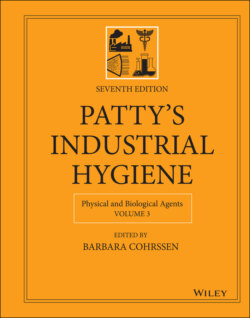Читать книгу Patty's Industrial Hygiene, Physical and Biological Agents - Группа авторов - Страница 92
7 LASER EYE PROTECTION
ОглавлениеLaser eye protection becomes of great importance when engineering controls such as enclosures, baffles, and barriers are inadequate to assure that persons will not enter the NHZ, where a potential ocular exposure will exceed the applicable MPE. The protective factor of the safety filter is normally expressed as a logarithmic quantity referred to as the optical density (D(λ), or just “OD”) for a given wavelength λ. The OD is the negative log10 of the transmittance. Hence a protective factor of one million corresponds to an OD = 6 since the log10 of 1 000 000 = 6.0. Therefore, the required OD for a given exposure is the calculated radiant exposure in J/cm2 divided by the MPE in J/cm2.
There are many commercial laser eye protectors available and standards have been written to test them. There has long been a controversy as to whether some of the tests related to filter damage are realistic and are not just a costly added expense. Some existing testing standards require the eye protection to withstand levels far in excess of skin injury thresholds, with the result that many are critical of these requirements (Figure 6). Efforts in the ANSI Z136 Committee to prepare a more realistic standard for eyewear (ANSI Z136.7) culminated in 2008 with the publication of a new standard for eye protectors and barriers, ANSI Z136.7:2008 and now in a 2nd Edition (2019) (21).
The ANSI Z136.7 standard represents an important advancement in providing manufacturers and testing laboratories with up‐to‐date and realistic test criteria for laser‐protective spectacles and goggles. Just what is important to specify and test has long been a focus for spirited discussions in laser‐safety committees. The first European standards were based upon German standards from the 1970s that attempted to provide users with specifications for laser eyewear that already incorporated MPE limits. The German standards committee had a strong background in testing and labeling of other forms of personal protective equipment and placed an early emphasis on testing for failure. One criticism of this early standard was that the user's needs appeared to play a secondary role, and the marking was not very informative unless one really knew the marking code (22, 23).
FIGURE 6 The absurdity of testing laser eye protectors to withstand kilowatt laser beams.
The ANSI standards subcommittee, SSC‐7, that prepared ANSI Z136.7 was particularly interested in developing standardized test methods for newer types of eye‐protectors. Many newer designs employ reflective technologies, such as holographic reflectors, since the true level of protection of such multi‐wavelength designs depend upon pupil diameter, eye movements, a fit tolerance, and eye relief as well as simply the optical properties of the filter. These require very involved point‐by‐point testing over the surface for these sophisticated filter systems.
To minimize the cost and complexity of filter‐material damage thresholds, the ANSI Z136.7 standard introduced the concept of default damage (failure) threshold values for substrate materials, where – unless the manufacturer wanted to claim substantially higher laser‐induced damage thresholds – damage testing would not be required. Values for plastics, glass, and quartz were specified, and the manufacturer could refer to these time‐dependent damage‐threshold values without the need for testing each product. As an example, the failure threshold value (TVmax) for polycarbonate lenses is given as 10 J cm−2 for pulse durations t < 1 ms and 300 t0.5 J cm−2 for t > 1 ms. Glass and quartz have higher values of TVmax for CW lasers, but actually somewhat lower TVmax for short pulse durations. Of course, testing for saturable absorption (transient, reversible bleaching) of absorbers from very‐short‐pulse lasers would always be required, and radiant exposure test levels for Q‐switched and mode‐locked laser pulses are provided. The ANSI TSC‐7 subcommittee members felt that it was inappropriate to place much emphasis on substrate damage of goggle materials at levels well above skin injury thresholds, and hopefully this issue, which has been around for decades, will soon be forgotten (11, 24, 25).
